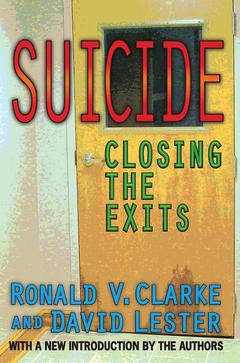Suicide Closing the Exits
Auteur : Clarke Ronald V.

Suicide prevention is a major goal of the Public Health Service of the US government. This has been the case since the 1960s when the National Institute of Mental Health established a center for the study and prevention of suicide. Since then, however, the knowledge and research gathered has not bought about the reduction of suicide. Suicide: Closing the Exits was written to change this trend.
This book reports a program of research concerned with preventing suicide by restricting access to lethal agents, such as guns, drugs, and carbon monoxide. It may seem implausible that deeply unhappy people could be prevented from killing themselves by "closing the exits," but the idea is not a new one and has been discussed widely in the literature.
The authors argue that restricting access to lethal agents should be considered a major preventive strategy, along with the psychiatric treatment of depressed and suicidal individuals and the establishment of suicide prevention centers to counsel those in crisis. Suicide represents a major contribution to the literature. As such, it should be read by all medical practitioners, policy makers, and psychologists.
Introduction to the Transaction Edition
Preface
1. Preventing Suicide
The Nature of the Problem
Strategies for Preventing Suicide
Reducing Access to Lethal Agents
The Research Plan
The Ethics of Preventing Suicide
Conclusions
2. Detoxification of Domestic Gas
Detoxification in England and Wales (Study 1)
Detoxification in Scotland and the Netherlands (Study 2)
Detoxification in the United States (Study 3)
Conclusions
3. The Toxicity of Car Exhaust
Car Exhaust Suicides in the United States (Study 4)
Comparison of the United States and Great Britain (Study 5)
Conclusions
4. Firearm Availability and Suicide
Suicide and Estimates of Gun Availability in the United States (Study 6)
A Further Attempt to Estimate Gun Availability (Study 7)
A Comparison of the United States and Australia (Study 8)
Gun Ownership in the United States and Suicide Rates from 1959 to 1984 (Study 9)
Conclusions
5. Handgun Control Statutes
Earlier Research on Gun Control Laws
Coding and Scaling the Gun Laws
Handgun Control and Deaths from Suicide (Study 10)
Characteristics of The Handgun Laws (Study 11)
Availability of Guns and Moral Opposition to Suicide (Study 12)
Conclusions
6. Displacement Between Methods
The Concept of Displacement
Evidence from the Present Studies
Availability of Drugs
Conclusions
7. Explaining Choice of Method
Availability and Accessibility
Suggestion and Symbolism
Personal Requirements and Cultural Norms
Choice Structuring Properties of Methods of Suicide
Perception of Different Methods (Study 13)
Reasons for Choice of Method (Study 14)
Conclusions
8. Implications for Theory and Prevention
A Decision Theory of Suicide
A Public Health Approach to Prevention
Suicide-Proofing the Environment
Reducing Acceptability and Suggestion
Conclusions
References
Index
Date de parution : 04-2013
15.2x22.9 cm
Date de parution : 09-2017
15.2x22.9 cm
Thème de Suicide :
Mots-clés :
Suicide Rate; rate; Car Exhaust; car; Lethal Agents; exhaust; Total Suicide Rate; lethal; Car Exhaust Gas; agent; Suicide Prevention Centers; domestic; Domestic Gas; gas; Firearm Availability; total; Fatal Toxicity Indices; united; Golden Gate Bridge; states; United States; Carbon Monoxide; Carbon Monoxide Content; Gun Suicides; Gun Magazine Subscriptions; Strictest Gun Control Laws; Gun Ownership; Gas Suicides; Choice Structuring Properties; Gun Suicide Rate; Handgun Control; Completed Suicide; Bay Bridge; ICD Revision; National Opinion Research Center



